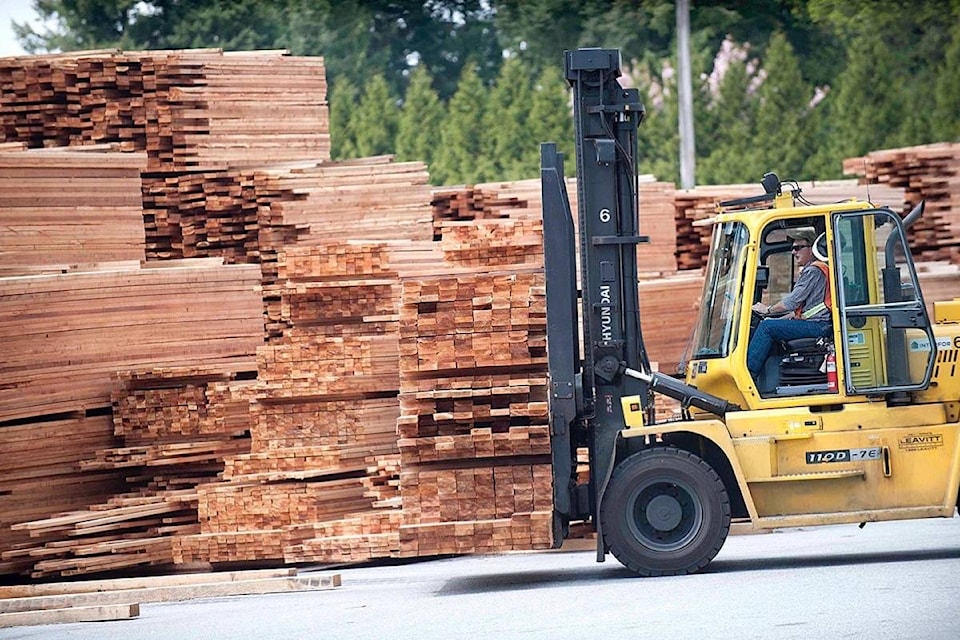Another bruising week for B.C.’s forest industry featured the indefinite shutdown of Tolko Industries’ sawmill at Kelowna, and the halt of what was left of Vancouver Island and Fraser Valley logging by contractors for Teal-Jones Group, which runs three mills in Surrey.

That’s 600 more mill workers either out of a job or soon to be as their log supply runs out, plus contracted loggers and haulers. Add that to Interfor’s permanent closure of the century-old Hammond Cedar sawmill in Maple Ridge and West Fraser’s move to “variable operating schedules” at its sawmills and plywood plants at Williams Lake, Quesnel, 100 Mile House, Chetwynd and Fraser Lake. All in a 10-day period, and all due to the now-familiar mixture of low lumber prices, high log costs, diminished log supply and U.S. trade sanctions.
Teal-Jones added two more factors in its second decision this summer to lay off loggers: “Current high stumpage rates remain high relative to lumber prices, and harvesting costs have been adversely impacted by new regulations to bring out more residual waste fibre.”
RELATED: Hundreds of Teal-Jones workers await end of log supply
RELATED: Closure sad day for Hammond mill families, community
Stumpage, the province’s Crown timber fee, is adjusted quarterly and hasn’t kept up with plummeting lumber prices this year. And the NDP has cracked down on residual waste, charging triple stumpage on any wood left behind that is deemed to be economically usable.
Forests Minister Doug Donaldson says the residual wood program is just getting going, defining economic hauling zones, and may need some adjustments. But industry should get used to it. The days of huge slash piles left behind after the sawlogs are trucked out are coming to an end, and not just on the B.C. coast.
“I’m expecting we’re going to hear about this in the Interior renewal process that we’re undertaking as well,” Donaldson told me. “Wood left in slash piles that could be used for other purposes is consistent. The key is ensuring that those policy changes are applied where there is an economic analysis that it’s economical to bring that wood out.”
B.C. Liberal forest critic John Rustad says the new residual rules pile on harvesting costs at the worst possible time, and it’s backfiring as logging slows rather than running at a loss. Instead of getting extra residual wood, pulp mills are grinding more logs to keep going, he says.
Traditionally, residual fibre is collected by a second logging crew, mainly for pulp. Nowadays we also have pellet manufacturers feeding power plants in Europe, and value-added producers making everything from log homes to windows, doors, siding and other specialty products. Donaldson wants all usable wood taken out on the “first pass” of logging.
Donaldson made his first visit to the Global Buyers Mission event in Whistler last week. It’s the 16th annual trade show held by B.C. Wood, the value-added manufacturers group. Held in the ski resort that symbolizes B.C. wood construction world-wide, it had 270 industry representives hosting buyers from 20 countries, including Australia, Mexico, the U.K., the U.S., India, Japan and China.
B.C. Wood’s tracking system reports $38 million in sales from the Global Buyers Mission last year, Donaldson said. And some specialty products are made from residual wood that doesn’t fit the traditional measure of eight-foot construction lumber.
“It aligns well with what we’re focused on as the direction for the forest sector in the future, maximizing value rather than just maximizing volume,” he said. “That’s the way we’ve got to go.”
Tom Fletcher is B.C. legislature reporter and columnist for Black Press Media. Email: tfletcher@blackpress.ca
@tomfletcherbc
tfletcher@blackpress.ca
Like us on Facebook and follow us on Twitter.
